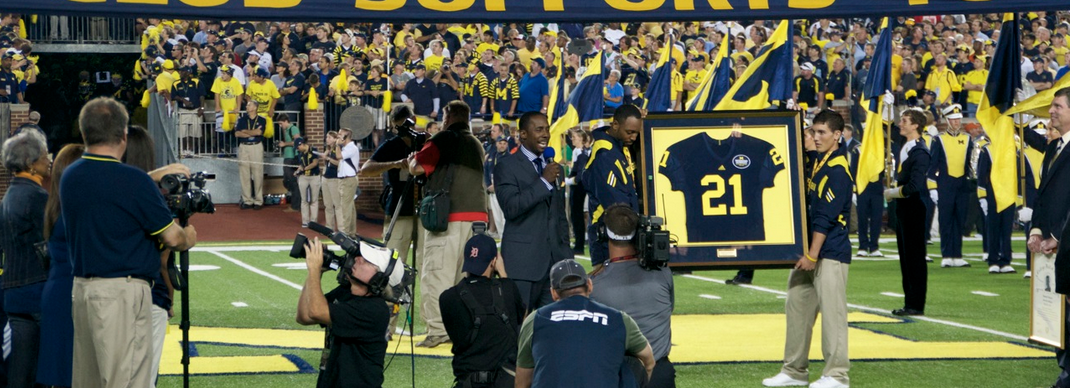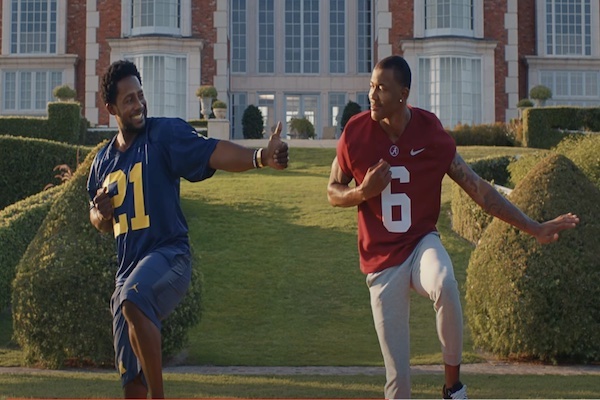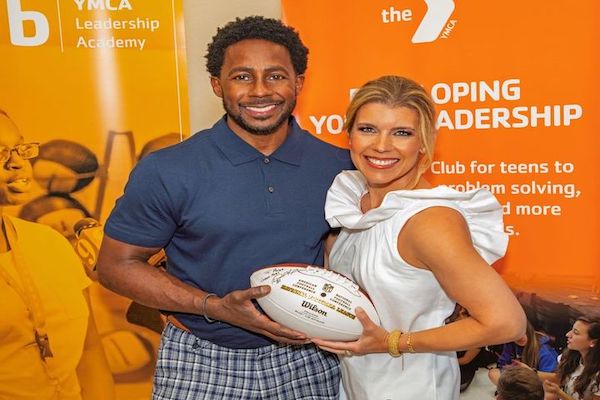By: Chris Huston:
Every year, the Heisman Trust honors the 50th, 25th and 10th anniversary recipients of the most prestigious trophy in sports. This year, our honorees are Steve Spurrier, Desmond Howard and Troy Smith. The following article appears in the 2016 Heisman Memorial Trophy program.
Desmond Howard, 25th Anniversary Heisman recipient
As a general rule, the best way to positively affect the outcome of a football game is to have the ball in your possession as often as possible.
That’s why so many quarterbacks and running backs have won the Heisman Trophy – they touch the ball far more frequently than do other positions.
The disadvantage of being a wide receiver competing for the Heisman is that your success is dependent in large part upon the ability of your quarterback to deliver you the ball.
But if you are a really special receiver, like Desmond Howard, you can always take matters into your own hands.
That’s what Howard did during his football career, displaying pure magic in the open field on his way to capturing Michigan’s second Heisman Trophy.
The 5-10, 175-pounder from Cleveland garnered All-Ohio honors as a 1987 senior at St. Joseph High, scoring 18 touchdowns while also snagging 10 interceptions on defense. An excellent all-around athlete, he earned letters in football, track and basketball. Not surprisingly, there were plenty of high-profile football programs hoping to land his services. After some consideration, Howard narrowed his choices to five schools: Georgia Tech, Michigan, Michigan State, Purdue and Syracuse. In the end, he picked the Wolverines over the Yellow Jackets. The fact he’d be playing for the legendary Bo Schembechler made all the difference.
“At the end of the day, for me, when I sat in front of Coach Schembechler and he told me if I came to Michigan … it was an honor,” Howard told ESPN years later.
But what position would Howard play for Michigan?
“When I recruited him, I really didn’t know where we would use him,” former Michigan coach Gary Moeller (then an assistant for Bo) told the LA Times. “He was small and not that fast, but the St. Joseph coaching staff kept telling us what a competitor he was until we finally took him.”
He showed up on the first day of Michigan’s fall camp in 1988 as a defensive back, moved to running back on the second day and by day three was a wide receiver. The transition didn’t go smoothly, as Howard was forced to redshirt the 1988 season and then caught just nine passes as a 1989 redshirt freshman.
He broke out as a sophomore, however, reeling in 63 catches for 1,025 yards and 11 touchdowns. He showed his versatility, too, rushing for 58 yards and averaging 29.6 yards on kickoff returns, with one kick return touchdown.
Howard was sublime as a 1991 junior.
He opened the season with three touchdown receptions and a 93-yard kickoff return touchdown to start the second half against Boston College. The next week, he caught six passes for 74 yards in a victory over Notre Dame. In addition, he established himself as a serious Heisman candidate by making a diving 25-yard fourth-quarter touchdown grab on 4th and 1 that sealed the victory for the Wolverines. “The Catch,” as it is called, is still talked about to this day.
“There’s no doubt that catch made me a candidate for the Heisman,” Howard told the media afterward.
Two weeks later against No. 1 Florida State he continued his high level of play, averaging 21 yards per touch, including four catches for 69 yards (and two touchdowns), three punt returns for 60 yards and two kickoff returns for 60 yards. Despite Michigan losing to the Seminoles, Howard was in the driver’s seat for the Heisman.
Despite the increased pressure and attention, he continued to dominate. Three of his five receptions against Indiana went for touchdowns. He caught six passes for a season-high 155 yards and two touchdowns against Minnesota. He snared seven balls for 108 yards and two TDs against Purdue while also averaging 26.5 yards on two punt returns.
Any doubts that he’d win the Heisman were swept away in the regular season finale against Ohio State. Howard’s last game in the Big House saw him catch three passes for 96 yards, gain eight yards on one carry and return a kickoff 16 yards, but it was his 93-yard punt return for a touchdown that etched his name in Heisman lore.
Howard slashed his way through the first wave of the Ohio State coverage team and then outran the rest of the Buckeyes on his way to the end zone. A few yards past the goal line, Howard struck the stiff-arm pose made famous by the Heisman Trophy. “Hello Heisman!” intoned ABC announcer Keith Jackson. It’s a sequence that has been replayed thousands of times ever since.
“That moment pretty much changed my life,” Howard said.
It also accurately presaged what was to come for the talented Wolverines receiver. Howard ended the regular season with 61 receptions for 950 yards with 19 touchdowns through the air, plus 165 yards and two scores on the ground, an average of 15.4 yards on 17 punt returns (with one score) and an average of 31 yards on 12 kick returns (with a TD). In total, he had 1,759 all-purpose yards and 23 touchdowns scored four different ways on just 102 touches, an average of over 17 yards per touch. He became the first receiver in Big Ten history to lead the conference in scoring (138 points) as he set or tied five NCAA records and 12 single-season Michigan records.
To no one’s surprise, the All-American won the Heisman by the second largest margin of victory in the trophy’s history.
“I dedicate this award to the 1991 Michigan football team because this was done through a team effort,” he said in his Heisman speech. “Hail to the victors and go Blue!”
The Washington Redskins drafted Howard with the fourth pick in the first round of the 1992 NFL draft. He ended up becoming one of the greatest kick returners in NFL history and won a Super Bowl MVP award with the Packers. He has since made a name for himself as a college football analyst for ESPN.
But, 25 years later, it’s still hard to top the magic of winning that Heisman.







About The Author: ME
More posts by ME